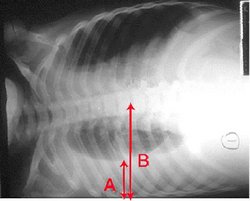PURPOSE: The purpose of this study was to evaluate the possibility of performing diagnostic thoracoscopy for patients with pleural effusions and inserting an indwelling catheter at the end of the procedure when intrapleural pathology was identifiable as possible malignancy, and discharging those patients on the same day of the procedure on domiciliary self drainage.
METHODS: Diagnostic thoracoscopy was performed under local anesthesia and conscious sedation, when a lesion was observed and judged to be the possible cause of the effusion and when it was thought that it was most probably malignant, a second skin incision was made 5 cm dorsal to the first incision. An indwelling catheter was tunnelled under the skin with the outer part of the catheter with the valve at its end coming out from the first incision. The fenestrated end was inserted into the pleural cavity through the second incision. Through the first incision, an intercostal tube was also placed. When patients recovered, they were asked to cough repeatedly until air stopped bubbling in the underwater seal. The intercostal tube was then removed and the indwelling catheter connected to surgivac pump to produce continuous negative pressure.
RESULTS: This technique was performed in eight patients with malignant pleural effusions who were diagnosed during thoracoscopy, all patients were discharged on the same day of the procedure, the intercostal tube was removed after a short period that ranged from 1 to 12 hours.
CONCLUSION: It is possible to minimize hospital stay after thoracoscopy for malignant pleural effusions by inserting an indwelling catheter to complete the draining of the effusion on an outpatient basis.
CLINICAL IMPLICATIONS: Patients with malignant pleural effusions can undergo thoracoscopy and be discharged home on the same day. This technique also abolished the need for chemical pleurodesis as the indwelling catheter have a comparable success rate in producing spontaneous pleurodesis.
DISCLOSURE: Ahmed Al-Halfawy, Product/procedure/technique that is considered research and is NOT yet approved for any purpose, placement of an indwelling pleural catheter at the same sitting of thoracoscopy for malignant pleural effusiosns and discharging the patient on the same day of the procedure.
Ahmed S. Al-Halfawy MD * Faculty of Medicine, Cairo University, Cairo, Egypt
COPYRIGHT 2005 American College of Chest Physicians
COPYRIGHT 2005 Gale Group



